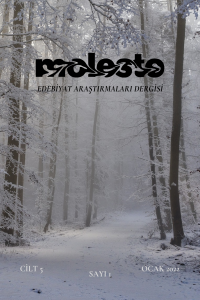Kutsal Örümcek Filminde 'İğrenç' Kadınlar
Bu makalede, 2022 yılında yayımlanan Ali Abbasi imzalı Kutsal Örümcek filminin feminist yaklaşım ile hazırlanmış bir analizi sunulur. Kadınların toplumdaki konumu ve rolü, insanlığın en önemli, değişmez problemlerinden biri olmuştur. Bu film ise İran'ın bu sorunla ilgili tartışmaların ve haksız ortamın hissedildiği ülkelerden biri olduğunu yansıtmaktadır. Dini ve milli duyguları sömürülen sıradan bir vatandaşın, şehirdeki tüm hayat kadınlarını öldürmeyi görev edinerek bir seri katile dönüştürülmesini konu alan bu filmde toplumsal açıdan pek çok eleştiri vardır. Bu nedenle, geniş bir bakış açısı ve çeşitli teoriler ile analizlere elverişli bir yapım olan Kutsal Örümcek ile izleyicinin, toplumsal cinsiyet rollerini, yozlaşmış siyasi ve dini tutumları ve devletlerin manipülasyon olarak kullandığı birçok aygıtın bireyler üzerindeki etkisini sorgulaması bekleniyor. Bu çalışma Kutsal Örümcek'teki bu sorunlu konuları Julia Kristeva'nın ‘iğrenç varlık’ ve Hannah Arendt'in ‘kötülüğün sıradanlığı’ gibi belirli kavramlar üzerinden incelemektedir.
Anahtar Kelimeler:
Kutsal Örümcek, İğrenç Nesne, Kötülüğün Sıradanlığı, İranlı Kadınlar
Abject Women in Holy Spider
This article presents a feminist reading of Holy Spider the movie inspired by real life and shot in 2022 under the direction of Ali Abbasi. The position and role of women in society have consistently been one of humanity's most significant strife. This movie reflects the fact that Iran is one of the countries where the discussions and unfair atmosphere about this problem are felt. The movie is about transforming an ordinary citizen whose religious and national feelings are exploited into a serial killer by making it his mission to kill all the prostitutes in the city. Therefore, with Holy Spider, a production that lends itself to analysis from a wide range of perspectives and theories, the audience is expected to question gender roles, degenerate political and religious attitudes, and the effects of many devices that states use as manipulation on individuals. This study examines these problematic issues in Holy Spider through certain notions such as Julia Kristeva’s abjection and Hannah Arendt’s banality of evil.
Keywords:
Holy Spider, Abjection, The Banality of Evil, Women in Iran,
___
- Abbasi, Ali, director. Holy Spider. 2022.
- Arya, Rina. “Abjection interrogated: Uncovering the relation between abjection and disgust.” Journal of Extreme Anthropology 1.1 (2017): 48-61.
- Beardsworth, Sara. Julia Kristeva: Psychoanalysis and modernity. State University of New York Press, 2012.
- Butler, Judith. “The body politics of Julia Kristeva.” Revaluing French feminism: Critical essays on difference, agency, and culture 3.682 (1992): 162 as.
- Cain, William E., et al., editors. The Norton Anthology of Theory and Criticism. 2nd ed., WW Norton, 2010.
- Cislaghi, Beniamino, and Lori Heise. “Gender norms and social norms: differences, similarities and why they matter in prevention science.” Sociology of Health & Illness 42.2 (2020): 407-422.
- Coşkun, Kübra Kangüleç. “Exploration of the Maternal Semiotic for Female Subjectivity in Evaristo’s The Emperor’s Babe.” Spring/Fall (2017): 107.
- Fazeli, Nematollah. Politics of culture in Iran. Routledge, 2006.
- Kristeva, Julia. Powers of Horror: An Essay on Abjection. Columbia University Press, 1982.
- Lacan, Jacques. Autres écrits. Paris: Seuil, 2001.
- Milchman, Alan, and Alan Rosenberg. “Hannah Arendt and the etiology of the desk killer: The Holocaust as portent.” History of European Ideas 14.2 (1992): 213-226.
- Miller, Stephen. “A Note on the Banality of Evil.” Wilson Quarterly 22 (1998): 54-59.
- Mostafaei, Somaye, and Ensieh Shabanirad. “Symbolic order in Sylvia Plath’s “Daddy” and “Lady Lazarus”: A Lacanian reading.” Anafora: Časopis za znanost o književnosti 2 (2018): 429-443.
- Muller, John P. Beyond the psychoanalytic dyad: Developmental semiotics in Freud, Peirce and Lacan. Routledge, 2014.
- Tyler, Imogen. “Against abjection.” Feminist theory 10.1 (2009): 77-98.
- Van Buren, Jane. “Mother-infant semiotics: Intuition and the development of human subjectivity—Klein/Lacan: Fantasy and meaning.” Journal of the American Academy of Psychoanalysis 21.4 (1993): 567-580.
- Yayın Aralığı: Yıllık
- Başlangıç: 2018
- Yayıncı: Bülent AYYILDIZ
